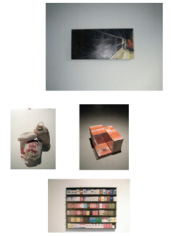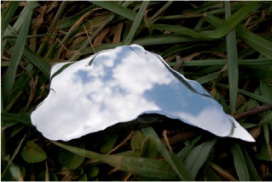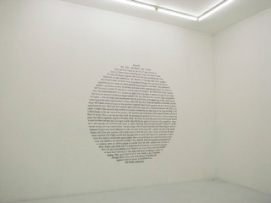| |
| |
|
|
|
|
| Pratchaya Phinthong |
| b. 1974, Ubon Ratchathani; lives and works in Bangkok |
| |
| Pratchaya Phinthong studied fine arts at Silpakorn University in Bangkok, and the Staatliche Hochschule für Bildende Künste Städelschule in Frankfurt. After completing his studies in Germany, he quickly became a leading figure in Bangkok’s thriving contemporary art scene. His work has been exhibited widely across Asia and Europe, featured in biennales in Taipei, Busan, Berlin and Singapore; in art fairs including Frieze (London), FIAC (Paris) and ShContemporary (Shanghai); and at prestigious galleries and institutions in France, Italy, Germany and the U.S. His recent solo shows include Give More Than You Take (Centre d'Art Contemporain, Brétigny, Paris, 2010) and The News of the Day, The Problem of the Hours (Bangkok University Gallery, 2011). Richly informed by the traditions of conceptualism and minimalism, Pratchaya’s work spans painting, sculpture, installation, photography and print, as well as social and community-oriented projects. His practice interrogates systems of value, exchange and dissemination – including those of art – and is seasoned with the chance poetry of the artistic process, the contingencies of personal and professional life. Pratchaya’s work is held by the Kadist Art Foundation (Paris), the Fonds National d'Art Contemporain (FNAC), and in numerous private collections. |
|
A Conversation with Pratchaya Phinthong
|
David Teh: Let's start at the beginning – or perhaps at the end… When you finished your studies in Germany, you made an epic, overland journey back to Thailand. Can you describe this mission?
Pratchaya Phinthong: I had in mind my father’s story. Back when he was in the monkhood, in a small village, he was keen to travel to Bangkok to study. Eventually, he graduated in Buddhist theology, the highest level of Buddhist Dhamma, and then returned to the temple in his hometown where he taught and worked for the rest of his life. My father had passed away a year before I finished school, so I was trying to conceive things by just going with the flow of the journey, and to realize what I had been doing in the preceding years. I left the school even before they held the graduation show. I left only a trace in the exhibition, borrowing works from other artists who had inspired me at that time. Then I traveled eastward, overland. There was not really a mission but I was trying to conceive a show out of the traveling, which did happen a year later, in 2005.
 |
|
Pratchaya Phinthong,
Missing Objects, 2004-05 (details).
Installation at The Art Center, Chulalongkorn University, Bangkok |
DT: The residues of this trip became the installation Missing Objects. Looking back at this, I'm struck by its formal diversity – books, photos and paintings, the archive of cigarette packets and other keepsakes – a kind of migrant bricolage. Each element denotes a certain memory, a piece of the bigger narrative. Is it about a journey, or a destination?
PP: The project is about myself, and others, other things, reflected in the many facets – the dimensions and destinations – of a journey. But it’s really more about searching inside yourself for the things that have struck you, left an impression – the things that have become thoughts, and how, etc. So I allow things to occur to me, I collect and recollect them in various forms. The exhibition was about trying to see how much of these stories could be contained by the objects, by their arrangement and (dis)play, to see what of the narrative would be trapped there. I really liked the challenge of making such a show.
DT: These days your itineraries are faster, more direct. Your work, too, has become more succinct. Has your practice changed?
PP: Things are always changing. I’m always working with completely different forms. In practice, a work may be grabbed from a mere trace of the journey. But there has to be a challenging form. Anyway, I like the feeling when you are waiting to catch a train.
DT: The trains tell an interesting story in Thailand. They’re a legacy of the fifth king, Chulalongkorn. They were an important modernising technology, not just practically (collapsing space) but also symbolically, collapsing the cultural distance between Siam and other countries. They reorganised seeing, too, especially the way Bangkok saw the provinces. And the camera was the chief accomplice. What is your interest in the rail-link between Bangkok and K.L.?
PP: Both the train and the camera have had an impact on the symbolic culture of modern Thailand. Together they constructed a whole visual paradigm, quite aside from the physical properties of the rail line inscribed on the landscape. Travelling to K.L. sets up a clear framework for proceeding towards a political and economic context. The tracks connect the two countries geographically, but there will always be ways to think around or beyond this framework, to work something out differently.
 |
|
Pratchaya Phinthong,
Untitled, 2009 (detail).
Four colour photographs |
DT: Your travel works open portals between places (I’m thinking of the town hall photos from Japan and Sweden, and If I dig a very deep hole). You’ve described this as an attempt to ‘materialise’ or ‘transcribe’ the journey. Vast distances are collapsed by very small, formal gestures – like a mirror, but an imperfect mirror. Your family is involved in the printing business; and reproductive techniques are prominent in your practice. There’s a strong sense of symmetry, yet the repetition is never absolute. Can you say something about this tension?
PP: I was born in a printing house. My father was also a writer; he invested in and published his own books – that’s why the printing house was there. The two works you mentioned were transcriptions, formal reproductions: the town hall photos imply how modernist structures are made and borrowed, but are reproduced in reverse. If I dig a very deep hole also collapses the vast distance separating two spaces – in the gap between two frames of the filmstrip, or on the world map. The idea here is about how things are defined, modes of perception and recognition.
 |
|
Pratchaya Phinthong,
2017, 2009.
Wall drawing in disappearing ink.
Installation view at gb agency, Paris |
DT: What about your meteorite photos? How did you find the meteorites, and how did you make these images?
PP: The piece 2017 (2009) is a large-scale wall painting made using disappearing ink and reproducing a text found on the internet, in which a scientific experiment (related to the CERN massive particle collider) gives rise to paranoid rumours and religious eschatological fears. The meteorite photos were hanging opposite this wall painting. They are four color photographs of meteorites, sliced and polished as mirrors, reflecting the sky where they just come from. They are from the Chinga Meteorite, which was discovered in the Chinga River bed in a remote part of Russia in 1911. I found a guy on the internet who chases, hunts, discovers all kinds of meteorites, and I bought four pieces from him. On one of my many trips between Bangkok and Chiang Mai, I decided to stop, throw them into the rice paddy and make photos.
By correspondence, Bangkok and Singapore, February 2011 |
|
| |
|
|
|
|

